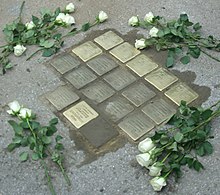Forced camp Salzburg-Maxglan
The Salzburg-Maxglan forced camp, or Gypsy camp in Nazi parlance , was set up by the National Socialists as part of the Porajmos . It existed from autumn 1940 to April 1943 and was located in the area of today's Kendler settlement in the Salzburg district of Leopoldskron-Moos , until 1939 an independent municipality, directly adjacent to Maxglan .
Most of the inmates, including many children, were murdered in the Nazi regime's extermination camps .
Forced labor
Sinti families camped in Salzburg-Parsch in the summer of 1940 on the local trotting track. On the orders of Reinhard Heydrich , they were to be relocated to Poland. For the time being they were locked up in a makeshift forced camp with their caravans, tents and in newly built barracks. There was a barbed wire fence and watchtowers. The 15-person team was led by SS-Sturmbannführer Anton Böhmer. All internees had to work. Women, children and old men did "homework" within the camp. Most of the men were used for hard forced labor , building the Reichsautobahn , regulating the Glan, or building the Rainer barracks in Glasenbach.
The forced camp was on the right side of the Glan, near the Schwarzgrabenweg. His official address was incorrectly Kräutlerweg 2 .
Lowlands
Leni Riefenstahl used a number of inmates for her film Tiefland because real Spaniards were not available. The shooting took place in Krünn near Mittenwald.
The publisher Helmut Kindler , who brought this up shortly after the end of the war, was sued by the director and convicted in 1949 by the Munich District Court for defamation .
Historical processing
The governing body Salzburg cultural sites is trying for many years to work up the biographies of all the victim groups and then stumbling blocks to commission. The city of Salzburg is - outside of Germany and after Amsterdam - the city with the most stumbling blocks. (Status: November 2018) This initiative is supported by an independent committee of persons.
The historian Gert Kerschbaumer was able to determine the names and fate of the Sinti who were interned. There were 245 children, women and men. The assertion made by Leni Riefenstahl that most of her extras survived the Nazi regime has proven to be a lie based on Kerschbaumer's research.
Eighteen stumbling stones on Schwarzgrabenweg and a memorial at the same place remember those imprisoned in the camp.
See also
- List_of_Stolpersteine_in_der_Stadt_Salzburg # Maxglan_und_Maxglan_West (Schwarzgrabenweg)
Web links
- Directory of the Sinti deported from Salzburg to Auschwitz-Birkenau B.II.e under the Nazi regime
- Website stumbling blocks Salzburg
- Maxglan gypsy camp in the Salzburger Nachrichten wiki
Coordinates: 47 ° 46 ′ 42.7 " N , 13 ° 0 ′ 33.5" E
